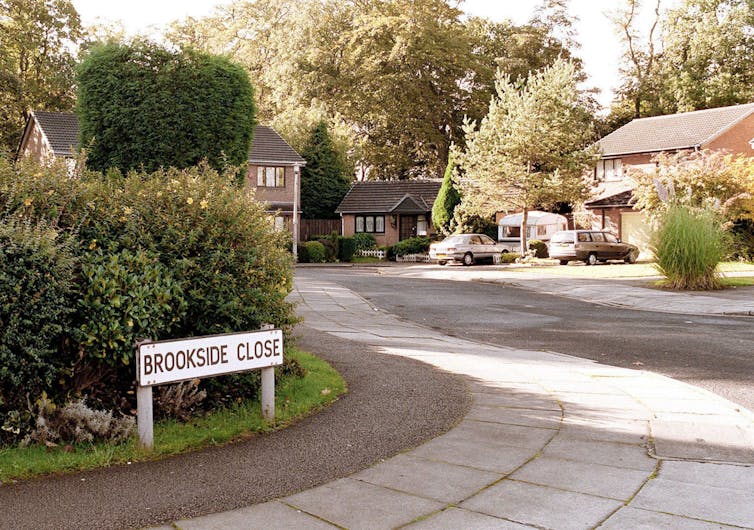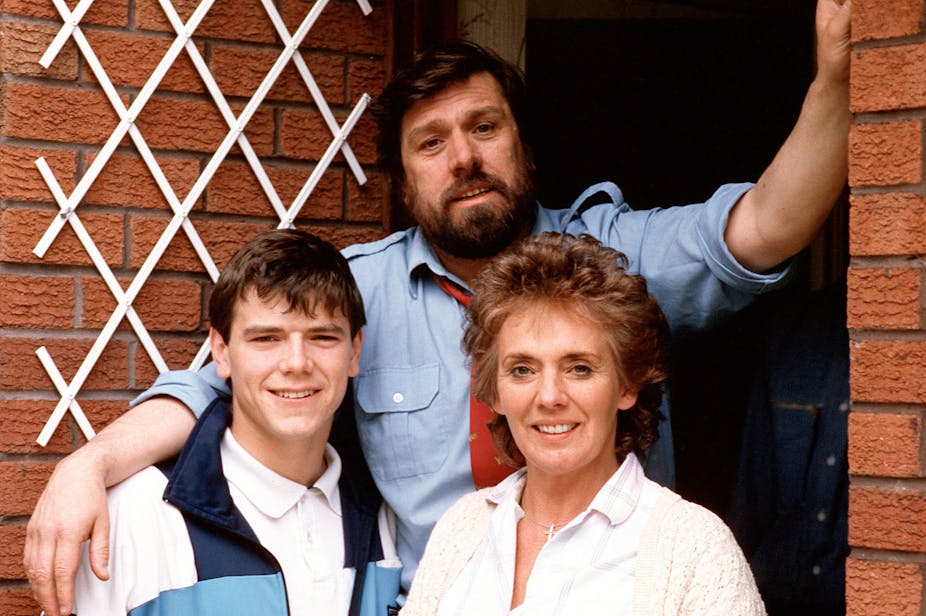If you want to understand how Margaret Thatcher shaped Britain, revisiting one particular 1980s soap opera is a great place to start. Brookside, a show set in a Liverpool cul-de-sac, ran for 21 years, airing just under 3,000 episodes between 1982 and 2003.
Brookside was therefore conceived amid the Thatcher administration’s first term, and a notable eight years of its broadcasting output coincided with her tenure.
The show is now being rebroadcast in full on digital channel STV. I’ve watched over 150 episodes so far, finding at the same time, a notable resource for social historians or indeed anyone interested in the contemporary impact and longer-term legacy of Thatcherism.
A distinctive location
Brookside Close, where the show was filmed, was not a TV set but part of a real private housing estate – at the time, Europe’s largest. To make Brookside, Mersey Television purchased a small corner of a flourishing development that saw around 1,000 new properties constructed over a seven year period in the 1980s.
The growing residential area typified the contemporary “new right” vision of aspirational home ownership.
According to the Thatcherite ideology of economic liberalism, such emerging estates would ideally produce a new generation of homeowners and, ultimately, Conservative-inclined voters. UK home-ownership increased during the 1980s and some areas with growing owner-occupation shifted towards the Conservatives at that time (particularly in the south east).
However, despite such private housing trends, there was a marked anti-Conservative swing in Liverpool’s six parliamentary seats between 1983 and 1987, considerably above the national average.

Riots had hit Liverpool’s Toxteth district in 1981 and were followed by allegations of government-driven managed decline. Meanwhile the city’s “Militant” city council was, by the mid-1980s, engaged in a high-profile ideological clash with Thatcher’s administration.
Brookside’s specific geographical location therefore provided a distinctive political edge and social barometer. It increasingly came to reflect the vibes of growing opposition to Thatcherism, which ultimately spread across the country as the decade progressed.
Fluid social status
Brookside featured class-based tensions that reflected the demographic change and social fluidity that emerged in the 1980s. Some recurring characters such as the Grant family represented the upwardly-mobile working classes – people who bought into housing developments like Brookside Close as part of the climb up the social ladder.
Meanwhile, families such as the Collins were part of a downwardly-mobile middle class. They represented the many people who had been forced to downsize and relocate as a result of money troubles brought on by the prolonged recession of the early 1980s.
There were also yuppies (the Huntingtons, who were younger and more affluent professional people with materialistic tendencies) and even characters from the very early computer technology generation (Alan Partridge, who worked from home before it was cool). The close also had black market wheeler dealers in Barry Grant and his associates, and houseproud neighbourhood busybodies (Harry Cross).

These character categories can be seen as illustrative of the times, particularly the shifting class dynamics and changing employment patterns fuelled by Thatcher’s policies. Most of the original families on the close were adapting to changes in the employment market, one way or another.
No such thing as society?
During the 1980s, Brookside increasingly featured a narrative of resistance towards Thatcherism. It was an outlook that stemmed from the leftwing politics of Brookside’s creator Phil Redmond and emerging writers like Jimmy McGovern.
Leftwing actors such as Ricky Tomlinson (who played Bobby Grant) further reflected this aura. Redmond lamented in 2021 that modern-day soap operas don’t “tackle the real social issues” in the same way they did in the 1980s.
The underlying anti-government sentiment could often be identified in Brookside’s dialogue. In mid-1983, for example, when Sheila Grant asked her husband Bobby “where would we be if we all thought about ourselves?”, he swiftly replied: “The Conservative party”.
But in their attempts to navigate their differences, the residents of Brookside Close challenged one of Thatcher’s most infamous assertions – that there is “no such thing as society … there are individual men and women and there are families”.
The sense of society and community that developed in the show’s plotlines would be one of its most popular traits, making it a ratings success by the middle of the decade.
Yet by the mid to late 1990s, the show went into decline following a relatively golden period of television popularity during the second half of the 1980s. There was perhaps less to rail against during the New Labour era. It could be argued that Brookside flourished while Thatcherism thrived.
To watch Brookside again in 2023 is to see Thatcher’s premiership both implicitly and explicitly reflected in contemporary everyday life. Characters from multiple families faced unemployment and there were even plotlines about strikes.
The struggle of meeting mortgage payments was ever present for residents on the close and tensions between generations and classes played out in often spectacular fashion.
Brookside thereby provides a human angle by which to analyse the impact of some of Thatcherism’s most high-profile policies during a monumental decade of cataclysmic political and social change.

